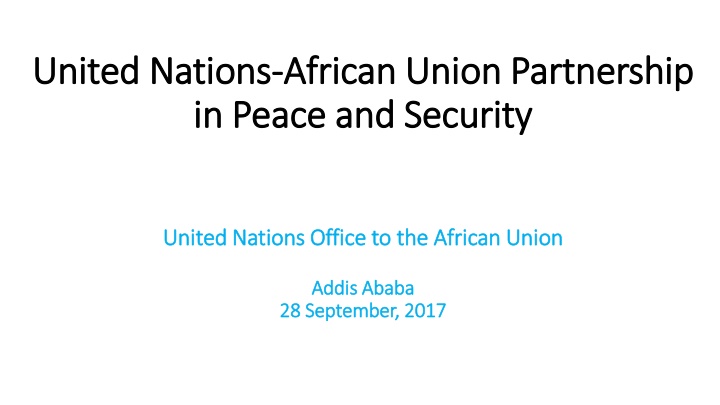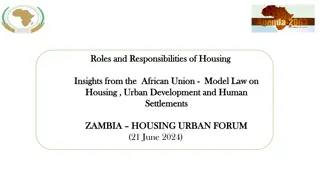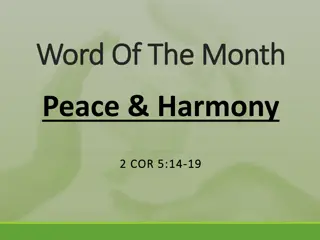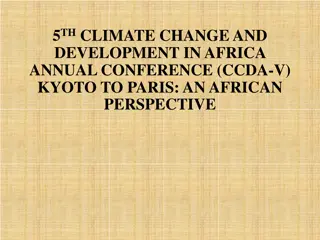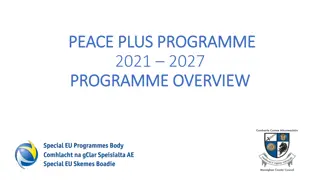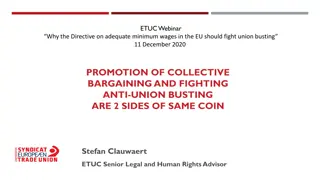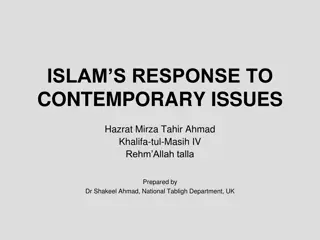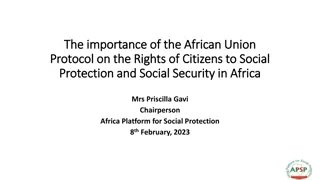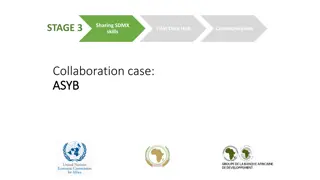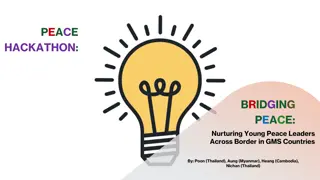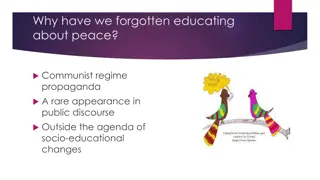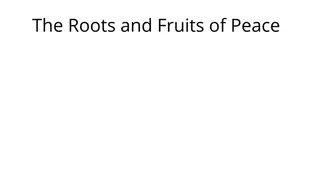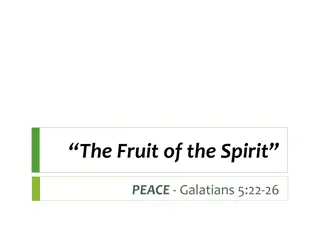African Union Partnership in Peace and Security
A society in perpetual conflict due to limited resources competition maintains social order through domination and power, not consensus. Understanding conflict dynamics requires exploring political, economic, social, cultural, and technological factors. UN-AU cooperation aims to address conflicts in Africa through effective partnerships based on actors' strengths and comparative advantages. With a focus on African solutions to African problems, these partnerships emphasize ownership and complementarities for sustainable peace and security.
Download Presentation

Please find below an Image/Link to download the presentation.
The content on the website is provided AS IS for your information and personal use only. It may not be sold, licensed, or shared on other websites without obtaining consent from the author.If you encounter any issues during the download, it is possible that the publisher has removed the file from their server.
You are allowed to download the files provided on this website for personal or commercial use, subject to the condition that they are used lawfully. All files are the property of their respective owners.
The content on the website is provided AS IS for your information and personal use only. It may not be sold, licensed, or shared on other websites without obtaining consent from the author.
E N D
Presentation Transcript
United Nations United Nations- -African Union Partnership African Union Partnership in Peace and Security in Peace and Security United Nations Office to the African Union United Nations Office to the African Union Addis Ababa Addis Ababa 28 September, 2017 28 September, 2017
Introduction Introduction A society is in a state of perpetual conflict due to competition for limited resources. It holds that social order is maintained by domination and power, rather than consensus and conformity- Karl Marx (Conflict Theory). A mix of political, economic, social, cultural, technological factors underlie the majority of conflicts. Effective solutions call for deeper understanding of the dynamics in the causal and secondary factors. Effective and efficient responses call for Partnerships based on the actors comparative advantages.
Background Background World Summit Outcome of 24 October 2005. Enhanced UN-AU Cooperation: Framework for Ten Year Capacity Building Programme-Nov 2006. Now replaced with the Partnership on Africa s Integration and Development Agenda (PAIDA). The report of the High Level Independent Panel on UN Peace Operations (HIPPO-2015) and the subsequent SG report.
Normative Principles Normative Principles Chapter 8 of the UN Charter. -Article 52 .1. Nothing in the present Charter precludes the existence of regional arrangements or agencies for dealing with such matters relating to the maintenance of international peace and security as are appropriate for regional action, provided that such arrangements or agencies and their activities are consistent with the Purposes and Principles of the United Nations. AU Peace and Security Protocol - MINDFUL of the provisions of the Charter of the United Nations, conferring on the Security Council primary responsibility for the maintenance of international peace and security, as well as the provisions of the Charter on the role of regional arrangements or agencies in the maintenance of international peace and security, and the need to forge closer cooperation and partnership between the United Nations, other international organizations and the African Union, in the promotion and maintenance of peace, security and stability in Africa;
Context Context Global mandate: Primacy of Security Council on international peace and security. Focus on Africa: UNSC devotes over 70% of its time and tight PK resources (Approx. $7 billion and 94,154 uniformed personnel) to conflicts in Africa. Increasing nature and complexity of conflicts in Africa, with hardly any peace to keep, is beyond what a single organization can address. Emphasis on ownership African solutions to African problems , with win-win partnerships based on complementarities. Comparative Advantage based on proximity, understanding and willingness to act ad hoc security initiatives like MNJTF, AU RCI LRA and G5 Sahel. Transforming the partnership into a predictable, systematic and strategic one (UNSCR 2320 (2016) and AUPSC Communique of 29 Nov 2016).
Rationale Rationale From partnerships driven by a sense of urgency to that of necessity. Is the UN behind the curve? The HIPPO Report outcomes = towards a more effective management of contemporary conflicts through timely consultative, collaborative and cooperative approaches for conflict early warning, prevention and management. (preventive diplomacy, mediation, peacekeeping, peace enforcement and peace building). Shift from ad hoc to a systematized, structured and predictable approach to addressing conflict in Africa. Towards actualizing the long term AU & UN objectives with regards to leveraging both Agendas 2063 & 2030; and the initiative to silence the guns by 2020.
Evolution of Relationship Evolution of Relationship United Nations Liaison Office to the AU (DPA Office)- 1999; Transformation from OAU to AU; PSC Protocol; establishment APSA; Joint UN-AU Declaration 2006; Establishment of DPKO & DFS offices 2007/8; Prodi Panel Report of 2008; Establishment of UNOAU on 1 July 2010; Restructuring of UNOAU 2013/14; Recommendations of HIPPO Report of 2015; Joint UN-AU Framework for an Enhanced Partnership in Peace and Security 2017.
Development of the Joint Framework Development of the Joint Framework Over 2 years of extensive consultations between AU and UN. Joint Framework between UNOAU and AU PSD in 2014. Joint Framework on Enhanced Partnership between the UN and AU, 19 Apr 2017 in New York. Renewed commitment by both UNSG and AUC Chairperson to strengthen the partnership. Convergence of interest by both leaderships on matters of peace and security as indicated by their visits to key trouble spots in Africa on resumption of office.
Partnership Principles Partnership Principles Full jointness may not always be achievable, but maximum convergence between the two Secretariats will always be the goal. Attainment of peace through joint efforts. Priority on prevention and the search for sustainable political solution. POC, Human Rights and respect for IHL are fundamental. Mutual respect. Comparative advantage. Clear division of labor and consultation. Transparency and accountability.
Conflict Spectrum Conflict Spectrum
Essential Themes Essential Themes Preventing and Mediating Conflict and Sustaining Peace. Responding to Conflict. Addressing Root Causes. Continuous Partnership Review and Enhancement.
Implementation Mechanism and Process Preventing and Mediating Conflict and Sustaining Peace. Responding to Conflict. Addressing Root Causes. Continuous Partnership Review and Enhancement
Progress Progress Increased collaboration and complementarity of efforts among Special Reps/Envoys of both organizations in a number of situations. Frequent Joint briefings by UN and AU Special Representatives. Dedicated statements by UN and AU Representatives. Technical level collaboration, including horizon-scanning, joint analysis and assessments, and joint operations planning. Increased recognition of the important and critical role of the AU and its RECs/RMs, (conflict contexts).
Challenges Challenges Divergent interpretation of Chapter VIII of the UN Charter with regards to the role of regional organizations. The inherent generic conceptual divergences between agreement and consensus among multilateral institutions. Sustainable financing: case by case basis precludes predictability and undermines planning. Ensure A3 is actually representative of AU s voice within the UN Security Council. Changing policies of members of the UN Security Council. Division of labor 25% - 2% levy - a solution to Africa s contribution. Mutual suspicion and skepticism within the UN and AU .
Going Going Forward Forward: : Joint field missions by both Councils, more frequent interactions, in particular in advance of mandate decisions. Sustained briefings from AU Special Representatives and Envoys, alongside their UN counterparts. Better collaboration with AU RECs and RMs. Building more responsive than reactive mechanisms especially for early warning. Implementing decisions on financial burden-sharing for AU Peace Support Operations authorized by the Security Council in line with resolution 2320.
Conclusions Conclusions Holistic and practical approach for a more systematic, effective and results- orientated partnership. Joint UN-AU analysis and understanding of conflicts. Early engagement in effective conflict prevention. Emphasis on the political solutions of conflicts. Coordinated mediation efforts. Enhanced partnership in peace operations. Enhance coordination and coordination in peacebuilding strategies. Ownership and comparative advantages.
Q & A Q & A
